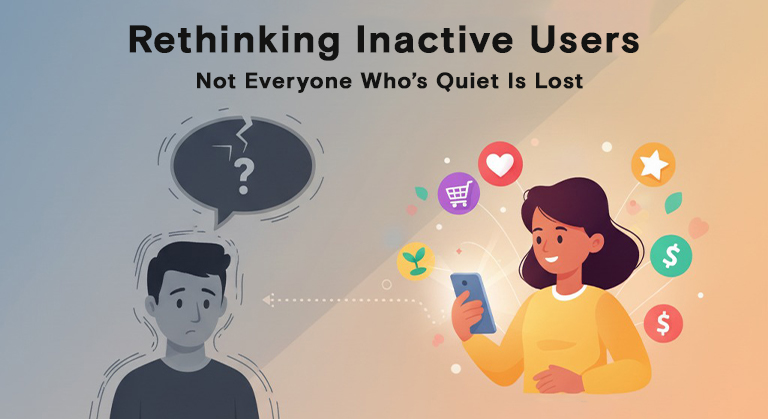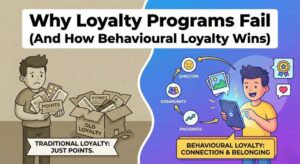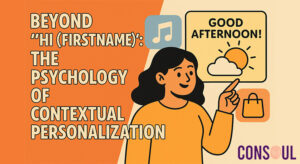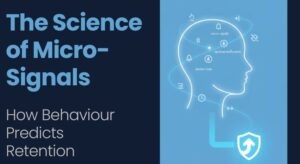In most lifecycle marketing and CRM strategies, users tend to be segmented into neat buckets: active, dormant, churned, and loyal. But reality is rarely this clean. Many users fall into a grey area — seemingly inactive but quietly engaged in ways that traditional dashboards don’t capture.
This group is often overlooked or misclassified as lost. Brands rush into aggressive reactivation tactics that feel irrelevant, intrusive, or unnecessary, missing the opportunity to design journeys that respect a user’s current state.
It’s time to rethink what inactivity means and build low-pressure journeys for the semi-engaged.

What does “inactive” really mean?
In most CRM setups, inactivity is defined in simplistic terms: no purchase in the last 30 days, no session in 14 days, or no response to the last few campaigns.
But this definition misses nuance.
What about the customer who reads your emails but hasn’t clicked yet?
Or the user who browses your app periodically but hasn’t checked out?
These users are still present — observing, considering, and engaging at their own pace. Labeling them “inactive” simply because they haven’t converted recently leads to poorly targeted interventions.
True inactivity is not just the absence of transactions. It’s the absence of all meaningful signals.
Silent signals: The behavior you might be missing
Many quiet users leave digital footprints that don’t immediately lead to conversion but indicate latent intent or awareness.
These silent signals include:
- Email opens without clicks: Users who remain subscribed, open emails, but take no further action
- Browsing sessions without purchase: Returning visitors who explore categories, view products, or check prices
- Wishlists and saved items: Activity that shows interest but at a later purchase horizon
- App sessions without transactions: Casual check-ins to browse new arrivals or monitor offers
These are not dormant users — they’re quiet but present.
They require nurturing, not rescue.
Why aggressive reactivation can backfire
The standard playbook for inactive users often leans into urgency: heavy discounting, repeated retargeting, frequent follow-ups.
While this may work for genuinely dormant customers, applying the same strategy to semi-engaged users risks alienation:
- Email fatigue: Excessive frequency drives unsubscribes or inbox blindness
- Irrelevant timing: Pushing offers when the user isn’t ready feels pushy rather than helpful
- Missed opportunity to build trust: Aggressive outreach suggests a brand is not paying attention to actual user behavior
In short, treating all quiet users as if they’re lost can cause more harm than good.
Low-pressure journey design for the semi-engaged
So how can brands nurture the semi-engaged without overwhelming them?
The answer lies in low-pressure, contextually relevant journeys:
- Gentle reminders: Occasional prompts about saved items or categories browsed
- Content-driven touchpoints: Curated emails or app notifications showcasing new arrivals, guides, or recommendations rather than pushing promotions
- Behavior-based personalization: Customizing communication based on recent passive signals (e.g., if a user browsed but didn’t add to cart, show related products)
- Respectful retargeting: Using soft retargeting (e.g., native app banners) instead of repeated ads across platforms
This strategy requires a mindset shift from chasing immediate conversion to sustaining light engagement until the user is ready.
Measurement beyond transactions
Redefining inactivity also means expanding how we measure success.
Instead of measuring success purely by purchases or conversions, marketers should consider:
- Return visits: Even if they don’t convert, are users coming back to your site or app?
- Scroll depth and session time: Are they engaging meaningfully with content?
- List engagement: Are they opening emails consistently, even if they don’t click?
- Wishlist activity: Are they curating products or expressing future intent?
Tracking these signals helps marketers distinguish between truly dormant users and those who are just on a slower path to conversion.
Case example: A nuanced retention fix in eCommerce
An eCommerce brand we worked with had a standard 30-day reactivation campaign triggered when a user didn’t purchase within 30 days.
Analysis revealed a group of “quiet browsers” — users who hadn’t bought anything in 45 days but continued to browse once a week and open emails regularly.
Instead of treating them as dormant, we designed a low-pressure journey:
- Monthly curated content emails (e.g., lookbooks, editor’s picks)
- Occasional wishlist nudges
- Personalization based on browsing categories
Result:
A 1.8x lift in eventual conversion compared to aggressive discount-driven reactivation emails.
The key was recognizing that these users weren’t lost — they just didn’t need urgency-based intervention.
Takeaway: Respecting quiet users in lifecycle strategy
Many lifecycle strategies focus heavily on the loud signals: transactions, cart additions, form fills.
But modern marketers need to listen for the quieter signals too: browsing behavior, content engagement, wishlist activity.
Not every quiet user is a lost customer.
Many are still engaged — just at their own pace.
By designing low-pressure, thoughtful journeys for this segment, brands can:
- Reduce unsubscribes and churn
- Build long-term trust and affinity
- Improve conversion over time — without aggressive discounts or intrusive campaigns
A simple checklist to get started:
- Redefine inactivity based on behavior, not just absence of transactions
- Identify semi-engaged segments who may not need rescue
- Design soft-touch journeys with content, curation, and personalization
- Measure intent signals and micro-engagements alongside conversions
- Respect user pace and avoid over-targeting
In today’s competitive environment, retention and loyalty aren’t just about fighting churn — they’re about understanding nuance.
Quiet users might not look “active” at first glance — but with the right strategy, they can become some of your most valuable customers over time.



